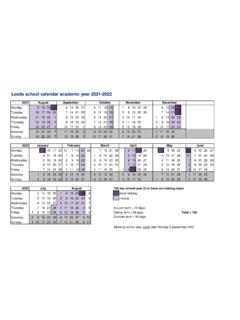Transcription of Using Writing in Mathematics to Deepen Student Learning - ed
1 Using Writing in Mathematics to Deepen Student & Products to Help All Students and Schools Succeed Since 1966, McREL has offered products and services aimed at improving Student achievement to educators, administrators, and policymakers. We work with clients to understand their strengths and challenges in order to know how best to support their efforts, whether it s providing a short workshop or comprehensive, long-term solutions. Visit our Web site at to find out what McREL s experts do in these areas: Curriculum & Instruction Standards & Assessment Learning 24/7 Leadership Development School & Systems Improvement Policy & StrategyRead more about our literacy-focused products and workshops on page 20.
2 2009 McREL20090609 AcknowledgementsThe following McREL staff members contributed to this publication. Kathleen Dempsey, Kuhn, Martindill, Writing in Mathematics to Deepen Student Learning Writing in Mathematics gives me a window into my students thoughts that I don t normally get when they just compute problems. It shows me their roadblocks, and it also gives me, as a teacher, a road map. Maggie Johnston 9th-grade Mathematics teacher, Denver, ColoradobyVicki Urquhart2 3 INTRODUCTIONW riting is the ability to compose text effectively for different purposes and audiences.
3 When many of us reflect on our own school experiences, we recall Writing in English and history classes, but not in Mathematics . Math classes previously relied on skill-building and conceptual understanding activities. Today, teachers are realizing that Writing during a math lesson is more than just a way to document information; it is a way to Deepen Student Learning and a tool for helping students gain new perspectives. They recognize, too, that students whose strengths are language-based and many are use Writing as the key to understanding other disciplines, especially Mathematics .
4 For example, Dr. David K. Pugalee (2004) conducted a study with 9th-grade algebra students to determine if journal Writing can be an effective instructional tool in Mathematics education and found that it may have a positive effect on problem solving because the writer must organize and describe internal thoughts. Like most things, Learning to write well requires instruction and practice. In this booklet, I aim to nudge secondary math teachers who are thinking about Using Writing in their classrooms more extensively and to encourage those who want to begin.
5 Perhaps you will come to the same conclusion as Mathematics educator Marilyn Burns, who said, I can no longer imagine teaching math without making Writing an integral aspect of students Learning (p. 30). Section One gives a brief background that answers the question you may be wondering: Why write in Mathematics ? Section Two describes the existing role of Writing in the Mathematics curriculum, and Section Three provides strategies and ideas to put into practice right away. Introduction4 OneSECTION ONE:What we know from research about Writing in the content areasResearchers agree that, like reading, improving Student s Writing skills improves their capacity to learn (National Institute for Literacy, 2007).
6 We also know that Writing fosters community in a classroom and, because Writing is a social act, it is a vehicle for students to learn more about themselves and others. Researcher Donna Alvermann (2002), an expert in adolescent literacy, studies students self-efficacy and engagement. She urges all teachers, despite their content area expertise, to encourage students to read and write in many different ways. She does so because she believes that Writing raises the cognitive bar, challenging students to problem solve and think critically.
7 What other single action requires students to be so grounded in a viewpoint that they can convince others, to know a process so thoroughly that they can explain it to someone else, or to grasp the nuances of an idea so deeply that they can convey it in a way that provokes thought and sparks discussion? I know that Writing does this for me each time I draft an article or prepare a workshop presentation. Until I read what I have written, I don t see the holes in my logic, the missing steps, or the rambling thoughts.
8 Writing informs me that I only have a cursory knowledge of the content when I need a deep one. Simply put, it doesn t let me cut corners. Whenever I have conducted workshops on Using Writing in Mathematics , math teachers, quick to see the parallels with problem solving, have rallied to the idea. Happily, teachers who want to begin infusing Writing in their instruction or who want to increase their use of it don t have to start from scratch. They can begin with their own well-crafted lessons and add a Writing activity that will enhance Student engagement and heighten cognitive demands.
9 Why are we Writing in math class?David Pugalee (2005), who researches the relationship between language and Mathematics Learning , asserts that Writing supports mathematical reasoning and problem solving and helps students internalize the characteristics of effective communication. He suggests that teachers read Student Writing for evidence of logical conclusions, justification of answers and processes, and the use of facts to explain their 5 In Writing Next, researchers Graham and Perin (2007) identify the following 11 elements of current Writing instruction that help young people learn to write well and to use Writing as a tool for Learning .
10 1. Teach students strategies for planning, revising, and editing. 2. Explicitly and systematically teach students how to summarize Use instructional arrangements in which students work together on Assign students specific, reachable goals for their Writing Use computers and word processors as instructional supports for Writing Teach sentence combining as a way to construct more complex, sophisticated Engage students in prewriting activities to generate ideas for Use inquiry activities where students analyze immediate.















